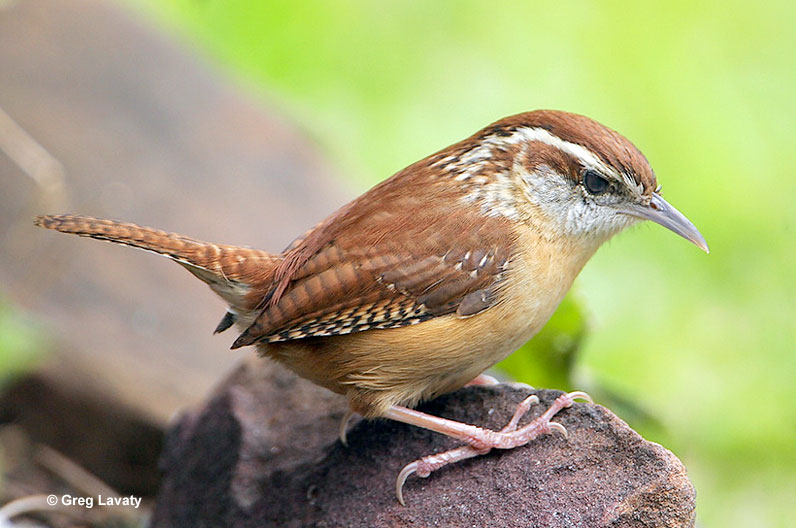Carolina Wren is a very shy bird, and because of this, it can be hard to see. They’re chunky, have long tails that are often tilted upwards, round bodies, distinctive bills that are downcurved, long and slender, and large heads with small necks.
In the summer months, Carolina Wrens inhabit what seems like every patch of woods in the eastern portions of the United States.
They deliver an incredible number of decibels for their size, and their rolling song can be heard often. Carolina Wrens are hardy birds that continue to travel farther north.
On this page
Breeding Male
Breeding male Carolina Wrens are bright birds. They’re warm buffy-orange below and unpatterned reddish-brown above. Carolina Wrens have dark bills, white chins and throats, and long white eyebrow stripes.
They’re 4.7 to 5.5 inches (12 to 14 centimeters) long and weigh 0.6 to 0.8 ounces (18 to 22 grams). These birds are slightly smaller than sparrows and somewhat larger than House Wrens.
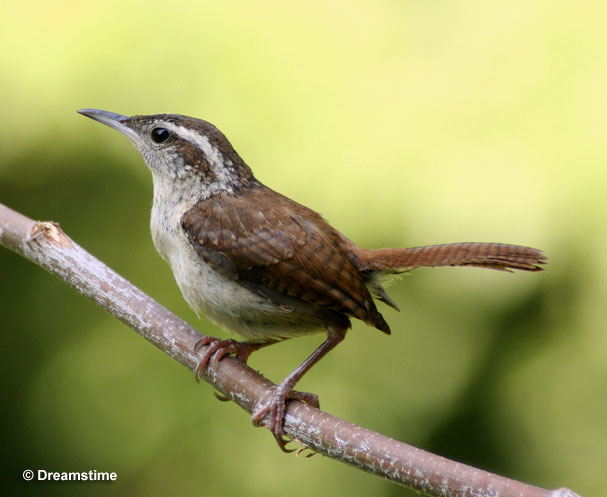
Female
Female Carolina Wrens look identical to breeding male Carolina Wrens.
Juvenile
It takes Carolina Wrens 12 to 14 days to hatch. The juvenile Carolina Wrens leave the nest when they hit 12 to 14 days old. The parents will continue to feed them. However, within 2 weeks of the young feeding, the mated pair has already started building another nest.
The population of Carolina Wrens in Florida is stouter and larger. They are more intensely colored below and a darker rusty chestnut above.
Habitat
Carolina Wrens inhabit vegetated areas such as lowland cypress swamps, brushy thickets, ravines choked with hemlock and rhododendron, and bottomland woods.
They gravitate toward overgrown farmland, wooded, shrubby residential areas, brushy suburban yards, and dilapidated buildings.
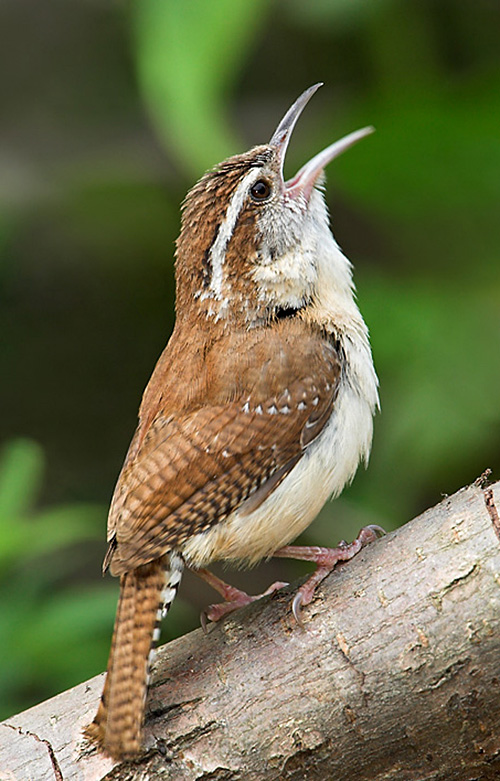
Copyright Glenn Bartley
Diet
Carolina Wrens mainly eat spiders and insects. Some common foods for Carolina Wrens are moths, caterpillars, stick bugs, beetles, leafhoppers, grasshoppers, cockroaches, and crickets.
Occasionally, these birds will eat frogs, snakes, or lizards. Some of the plant matter they consume are seeds from sweetgum, poison ivy, bayberry, and fruit pulp.
Carolina Wrens will visit backyard bird feeders. If you want to attract them, put out some mealworms suet, crickets, shelled peanuts, or peanut butter. It’s best to put these foods on tray feeders or shallow dishes, so they have easy access. Planting native shrubs that produce berries are another great way to attract them.
Behavior
Carolina Wrens usually do things alone or in pairs. After nestlings have left the nest during the breeding season, you may see groups of Carolina Wrens feeding together. This is a family of them. They feed near or on the ground, where they flit, hop, and run around tangled vegetation and leaf litter.
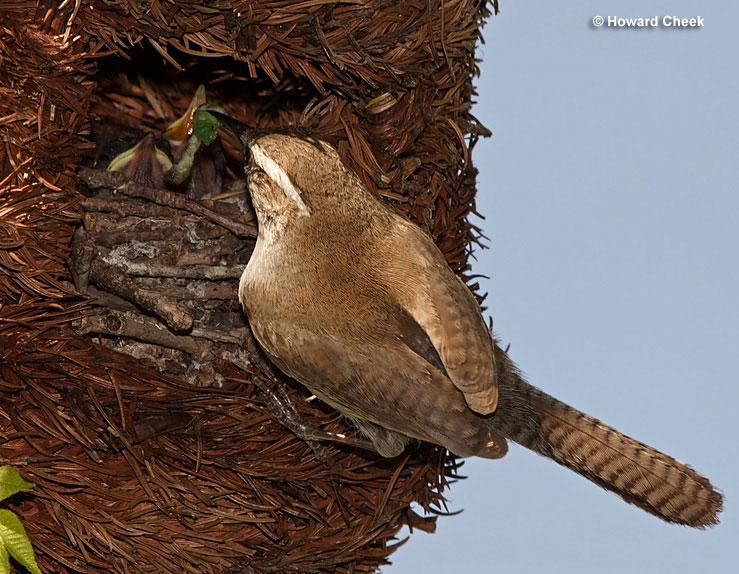
Carolina Wrens also climb trunks, branches, and vines, poke into squirrel nests, and probe nooks in search of insects. These birds use their unique downcurved bills to hammer and shake apart large bugs and turn over decaying vegetation.
They’ll roost in abandoned hornet nests, bird boxes, hanging plants, barns, garages, and old nests. They’re not great flyers, so they make brief aerial forays over short distances.
Range (and seasonal changes)
Carolina Wrens are year-round residents. They do not migrate. They’re found in the extreme south of Canada, the eastern half of the United States, and the extreme northeast of Mexico.
Wing shape
Carolina Wrens have pointed wings and a wingspan of 11.4 inches (29 centimeters). They fly with short flaps that are accompanied by violent jerks of the body and tail.
Fun Facts
- Carolina Wrens symbolize determination, change, happiness, and enthusiasm. The Celts held Wrens in high regard because their song was believed to be a message for the future.
- Carolina Wrens are very vocal birds. A captive Carolina Wren sang almost 3,000 times in one day.
- Carolina Wrens mate for life. They’ll form a bond at any time of the year and will stay together for life. They’ll remain in the same territory, together, year-round. They’ll also move around the territory and forage together.
- In the late 1940s, the Carolina Wren became South Carolina’s official state bird.
- The oldest recorded Carolina Wren lived to be at least 6 years and 2 months old.
Call
Male Carolina Wrens are the only ones who sing. Their song consists of a series of a number of quick, whistled notes that are repeated a few times. Their song usually lasts 2 seconds or less.
Each male Carolina Wren has a collection of different song variations, up to a dozen. Males will sing the same song about 15 times before changing it. Carolina Wrens have a wide range of calls; this includes rising and falling cheer, chattering, and loud repeated rasping.
When Male Carolina Wrens notice an intruder on their territory, they’ll slam into hard objects with an audible whirring of their wings in short flights.
Similar Species
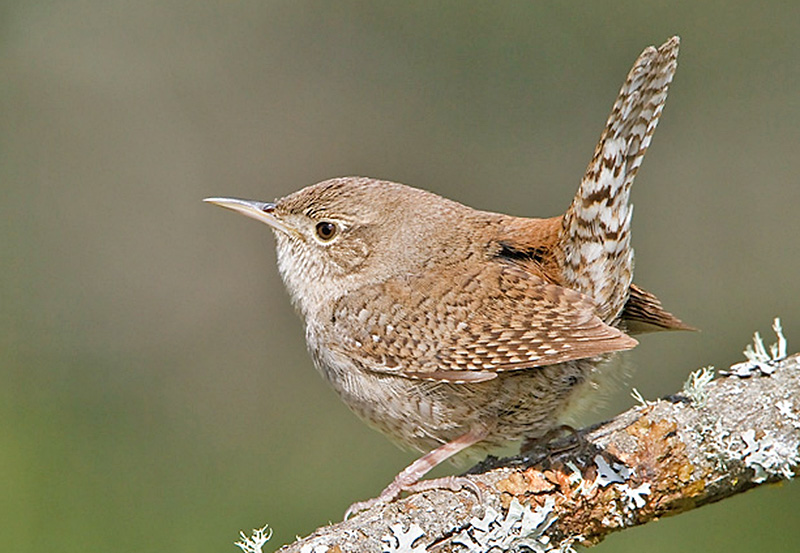
Photograph © Glenn Bartley.
Carolina Wrens and House Wrens look similar, but there are still some key differences.
First of all, House Wrens are a bit duller and darker in color.
They are also a bit smaller and have shorter tails than Carolina Wrens.
Frequently Asked Questions
What are Carolina Wrens known for?
Carolina Wrens are known for their ability to deliver an incredible number of decibels for their size.
What’s the difference between a House Wren and a Carolina Wren?
Carolina Wrens are larger, lighter in color, and have longer tails than House Wrens. Additionally, Carolina Wrens have white eyebrow stripes and chests.
Are Carolina Wrens friendly?
Wrens are naturally inquisitive birds. However, Carolina Wrens can be very shy. But, if you’re lucky enough to have one visit your backyard, they can become used to you. If that happens, they can become very friendly.
Why do Carolina Wrens sing so much?
Male Carolina Wrens are the only ones who sing, and they sing for a few different reasons. They mostly sing for territory and mating. He’ll sing in the spring and summer months to impress the females and attract a mate. The rest of the year, he’ll sing to announce his territory.

